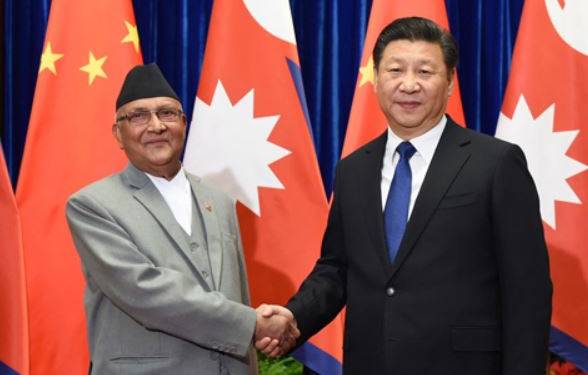The past few days have seen bilateral relations between New Delhi and Kathmandu reach new lows as the KP Sharma Oli government working at the behest of the Chinese Communist Party is determined to irreparably damage its ties with India. From blaming India for the spread of the coronavirus in Nepal to passing a new map of the Himalayan nation which now includes Indian territories and to murdering an Indian farmer along the Indo-Nepal border, the Oli government has done it all. The burning question is how does China have such a tight hold on the Nepalese government? The answer lies in the Chinese investment in the Himalayan nation which has witnessed a tremendous spike ever since the Oli led communists assumed the reins of Kathmandu.
Granted, that the Nepalese and Chinese governments have a similar ideological affinity and it was only natural to see Kathmandu cosy up to Beijing. However, to think that just for the cause of communism Kathmandu would severe its ties with India, with whom it also shares close cultural ties and open borders and of course, no ill-will among the people in both the countries, is foolhardy. The only reason which explains Nepal’s radical tilt towards China is because of the Chinese Foreign Direct Investment in Nepal.
In October last year, China pledged nearly $500 million in aid to Nepal. In the first quarter of the fiscal year 2019-20, China accounted for approximately 93% of total FDI committed in Nepal as it pledged a whopping $88 million in the first quarter. China is followed by the United Kingdom and India with the latter pledging $1.76 million. It is important to note that in the first quarter of the previous fiscal year, Chinese investments in Nepal were pegged at only $11.3 million.
China has come a long way in Kathmandu after investing only $1.83 million in 2003, Chinese FDI has been free-flowing ever since the communists took over in Kathmandu. In 2013/14, China accounted for 60% of Nepal’s FDI as it invested $174 million and during the Nepal Investment Summit in 2017, Chinese investors pledged over $8.3 billion in tourism-related projects.
China has followed its infamous debt-trap diplomacy in Kathmandu which sees China use its economic might to increase its influence in a country and gives humongous loans with punishing conditions which it knows the country won’t be able to pay back, and hence starts occupying the debtor’s territories and Nepal is the latest entry into a prospective Chinese client state.
In October last year, under the controversial Belt and Road Initiative, the Nepalese and Chinese governments inked $2.75b trans-Himalayan project during Xi Jinping’s visit to the Himalayan state. People familiar with BRI projects in Nepal share the same concerns of other BRI partners, as they claim that the projects are impractical and will further plunge Kathmandu into the Chinese debt-trap.
As Chinese investments continue to grow in Nepal, the trade deficit is heavily skewed in China’s favour as Nepal’s deficit with China has been increasing at the rate of 40% per year.
There is no doubt that the entire Oli government has been bought out by China as anti-India tirades are one thing, but including Indian territories in its map and murdering an unarmed Indian farmer along the border is a serious offence.
Oli it seems owes one to Xi Jinping as the latter saved his government which was destined to fall. There were tensions within the ruling Nepal Communist Party in Kathmandu, and a slit seemed imminent. Enigmatically, the warring factions led by party Chair Pushpa Kamal Dhal and senior party leader Madhav Kumar Nepal came head-to-head after China’s interference. Oli risked losing his chair, and this is when the Chinese Ambassador to Nepal Hou Yanqi jumped in, openly and deeply interfering in Nepal’s internal affairs. She held a series of meetings with senior Nepal Communist Party leaders to rescue Oli. Xi Jinping put all his weight behind the Nepalese Prime Minister which ultimately saved Oli and his government.
Nepal has passed the new map. Places that weren't on their map are now an integral part. The timing won't be ignored. China saved Oli govt right when India completed Lipulekh road, then Ch started a standoff with In & N went bonkers with nationalism at the cost of Indo-Nep ties.
— Shubhangi Sharma (@ItsShubhangi) June 13, 2020
If one takes a look at the chronology of things, one would realise how Beijing used the opportunity of driving a wedge in Indo-Nepal ties even as India prepared to inaugurate the Dharchula-Lipulekh road, a strategic project that allows India access to the strategically located Lipulekh Pass at a very high altitude of 17,060 feet, and only 4km away from the China border. It is also no coincidence that unlikely border disputes cropped up between India and Nepal at the same time when the Indian Army and People’s Liberation Army (PLA) of China troops came face-to-face in Eastern Ladakh.
Nepal is fast turning into a client state of China and will have dire consequences as it is hell-bent on severing its ties with India, despite being a landlocked country and thus heavily relying on India for its supply chain.


































